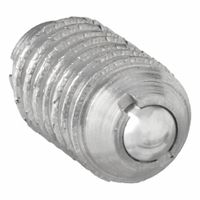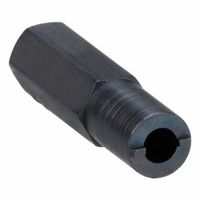Call +(254) 703 030 000 / 751 483 999 / 721 704 777
- Home
- Machining
- Clamping Workholding Positioning
- Indexing Positioning Equipment
- Ball Spring Plungers
.....Read More
Frequently Asked Questions
What are the differences between ball plungers and spring plungers?
Ball plungers and spring plungers are both types of indexing plungers used in various applications to position, index, or hold parts in place. Here are the key differences between them:
1. **Design**:
- **Ball Plungers**: These consist of a ball bearing housed in a threaded body. The ball is partially exposed and is pushed outward by a spring inside the body.
- **Spring Plungers**: These have a pin or nose that extends from the body, driven by an internal spring. The nose can be flat, rounded, or pointed.
2. **Functionality**:
- **Ball Plungers**: Primarily used for applications requiring smooth, rolling contact. The ball allows for easy movement and positioning, making them ideal for applications where frequent adjustments are needed.
- **Spring Plungers**: Used for applications requiring a more secure hold or precise positioning. The nose provides a more stable contact point, which can be beneficial in applications where the component needs to be held firmly in place.
3. **Applications**:
- **Ball Plungers**: Commonly used in fixtures, jigs, and assemblies where components need to be easily moved or adjusted. They are also used in detent mechanisms.
- **Spring Plungers**: Often used in applications requiring a more positive locking action, such as in latches, catches, or as a stop in mechanical assemblies.
4. **Load Capacity**:
- **Ball Plungers**: Generally have lower load capacities due to the smaller contact area of the ball.
- **Spring Plungers**: Can handle higher loads due to the larger contact area of the nose.
5. **Material Options**:
- Both types are available in various materials, including stainless steel, brass, and plastic, to suit different environmental conditions and load requirements.
These differences make each type suitable for specific applications based on the required movement, load, and environmental conditions.
How do I install a ball plunger in a fixture?
1. **Select the Right Ball Plunger**: Choose a ball plunger that fits the specifications of your fixture, considering size, material, and load requirements.
2. **Prepare the Fixture**: Ensure the fixture is clean and free of debris. Identify the location where the ball plunger will be installed.
3. **Drill the Hole**: Use a drill bit that matches the diameter of the ball plunger. Drill a hole to the required depth, ensuring it is straight and clean.
4. **Tap the Hole (if necessary)**: If the ball plunger is threaded, use a tap to create threads in the hole. Ensure the tap size matches the plunger's thread size.
5. **Clean the Hole**: Remove any metal shavings or debris from the hole using compressed air or a brush.
6. **Install the Ball Plunger**:
- For threaded plungers, screw the plunger into the hole using a suitable tool, such as a hex key or screwdriver, until it is flush with the surface.
- For press-fit plungers, gently tap the plunger into the hole using a mallet or press, ensuring it is seated properly.
7. **Test the Installation**: Check the plunger's operation by pressing the ball to ensure it moves smoothly and returns to its original position.
8. **Adjust if Necessary**: If the plunger is not functioning correctly, adjust its position or replace it with a different size or type.
9. **Secure the Fixture**: Once the plunger is installed and tested, secure the fixture in its intended application, ensuring the plunger operates as required.
10. **Regular Maintenance**: Periodically check the plunger for wear and ensure it remains clean and lubricated for optimal performance.
What are the common applications for spring plungers?
Spring plungers are versatile components used in various applications across multiple industries. Here are some common applications:
1. **Positioning and Indexing**: Spring plungers are often used to position and index components accurately. They provide a reliable way to hold parts in place, ensuring precise alignment and repeatability in manufacturing and assembly processes.
2. **Detent Mechanisms**: In mechanical systems, spring plungers serve as detent mechanisms, providing a tactile feedback or stopping point. This is common in knobs, levers, and other controls where a user needs to feel a click or stop.
3. **Fixture and Jig Construction**: In machining and fabrication, spring plungers are used in fixtures and jigs to secure workpieces. They help in maintaining consistent positioning during operations like drilling, milling, or welding.
4. **Door and Panel Latching**: Spring plungers are used in doors and panels to provide a secure latching mechanism. They ensure that doors remain closed or panels stay in place until a specific force is applied to release them.
5. **Electronics and Circuit Boards**: In electronics, spring plungers can be used to test circuit boards by providing temporary connections. They ensure contact without soldering, which is useful for testing and prototyping.
6. **Automotive and Aerospace**: In these industries, spring plungers are used in various components for positioning, locking, and securing parts. They are critical in applications where reliability and precision are paramount.
7. **Medical Devices**: In medical equipment, spring plungers are used for positioning and securing components, ensuring that devices function correctly and safely.
8. **Consumer Products**: Many consumer products, such as furniture and appliances, use spring plungers for adjustable features, providing ease of use and functionality.
These applications highlight the importance of spring plungers in providing precision, reliability, and ease of use across different sectors.
How do I choose the right plunger for my workpiece?
1. **Material Compatibility**: Choose a plunger made from a material that is compatible with your workpiece. For metal workpieces, steel or brass plungers are suitable. For softer materials like plastic or wood, consider using plastic or nylon plungers to prevent damage.
2. **Size and Dimensions**: Ensure the plunger size matches the dimensions of your workpiece. The plunger should fit snugly without excessive force. Check the diameter and length to ensure proper engagement and retraction.
3. **Force Requirements**: Determine the force needed to hold or position the workpiece. Choose a plunger with an appropriate spring force. Light-duty plungers are suitable for delicate tasks, while heavy-duty plungers are needed for more robust applications.
4. **Type of Plunger**: Select the type based on application needs:
- **Spring Plungers**: Ideal for applications requiring consistent force.
- **Ball Plungers**: Suitable for applications needing precise positioning.
- **Indexing Plungers**: Best for applications requiring frequent adjustments.
5. **Environment**: Consider the operating environment. For corrosive or high-temperature environments, choose plungers made from stainless steel or other resistant materials.
6. **Mounting Style**: Choose between threaded or press-fit mounting based on your setup. Threaded plungers offer easy installation and removal, while press-fit plungers provide a more permanent solution.
7. **End Tip Design**: Select the appropriate end tip design (e.g., flat, rounded, or pointed) based on the surface of the workpiece and the desired interaction.
8. **Cost and Availability**: Consider budget constraints and availability. Opt for a plunger that meets your requirements without exceeding your budget.
9. **Manufacturer and Quality**: Choose reputable manufacturers to ensure quality and reliability. Check for reviews or certifications if available.
What materials are ball and spring plungers made from?
Ball and spring plungers are typically made from a variety of materials to suit different applications and environments. The main components of these plungers are the body, the ball, and the spring, each of which can be made from different materials:
1. **Body:**
- **Stainless Steel:** Offers excellent corrosion resistance and is suitable for harsh environments.
- **Steel (Black Oxide Coated):** Provides good strength and wear resistance with moderate corrosion protection.
- **Brass:** Used for non-magnetic applications and offers good corrosion resistance.
- **Plastic (e.g., Delrin, Nylon):** Lightweight and corrosion-resistant, suitable for applications where metal contact is undesirable.
2. **Ball:**
- **Stainless Steel:** Commonly used for its corrosion resistance and durability.
- **Steel (Hardened):** Offers high strength and wear resistance.
- **Ceramic:** Provides excellent wear resistance and is non-magnetic.
- **Plastic (e.g., Nylon):** Used in applications requiring non-marring contact.
3. **Spring:**
- **Stainless Steel:** Offers good corrosion resistance and is suitable for a wide range of temperatures.
- **Music Wire (Carbon Steel):** Provides high strength and fatigue resistance but is less corrosion-resistant.
The choice of materials depends on factors such as the operating environment, load requirements, and the need for corrosion resistance or non-magnetic properties.
How do I maintain and care for ball and spring plungers?
To maintain and care for ball and spring plungers, follow these steps:
1. **Regular Inspection**: Periodically check the plungers for wear, corrosion, or damage. Look for signs of deformation or loss of tension in the spring.
2. **Cleaning**: Keep the plungers clean by removing dirt, debris, and any accumulated grease. Use a soft brush or compressed air to clean the plunger and its housing.
3. **Lubrication**: Apply a suitable lubricant to the plunger to ensure smooth operation. Use a light machine oil or a dry lubricant to prevent sticking and reduce friction.
4. **Corrosion Prevention**: If the plungers are used in a corrosive environment, consider using stainless steel or coated plungers. Apply anti-corrosion sprays or coatings as needed.
5. **Proper Installation**: Ensure that the plungers are installed correctly, with the right amount of tension and alignment. Use the appropriate tools to avoid damaging the plunger during installation.
6. **Avoid Overloading**: Do not exceed the recommended load capacity of the plunger. Overloading can cause premature wear or failure.
7. **Replacement**: Replace any plungers that show signs of significant wear or damage. Keep spare plungers on hand for quick replacement to minimize downtime.
8. **Environmental Considerations**: Be mindful of the operating environment. Extreme temperatures, moisture, or chemical exposure can affect the performance and lifespan of the plungers.
9. **Documentation**: Keep records of maintenance activities, including inspection dates, cleaning, lubrication, and replacements. This helps in tracking the performance and scheduling future maintenance.
By following these steps, you can ensure the longevity and optimal performance of ball and spring plungers in your applications.
What accessories are available for ball and spring plungers?
Accessories for ball and spring plungers include:
1. **Mounting Blocks**: These provide a stable base for installing plungers, ensuring precise alignment and positioning.
2. **Threaded Inserts**: Used to create durable threads in softer materials, allowing for secure installation of plungers.
3. **Locking Nuts**: These secure the plunger in place, preventing it from loosening due to vibration or movement.
4. **End Caps**: Protect the plunger tip and the surface it contacts, reducing wear and extending the life of both components.
5. **Spacer Rings**: Allow for adjustment of the plunger's protrusion, enabling fine-tuning of the force applied.
6. **Retaining Clips**: Hold the plunger in place within its housing, ensuring consistent performance.
7. **Sealing Boots**: Protect the plunger mechanism from dust, dirt, and moisture, enhancing durability.
8. **Adjustment Tools**: Specialized tools for adjusting the tension or position of the plunger, ensuring optimal performance.
9. **Guide Bushings**: Provide a smooth surface for the plunger to move against, reducing friction and wear.
10. **Extension Rods**: Increase the reach of the plunger, allowing it to be used in deeper or more recessed applications.
11. **Stop Collars**: Limit the travel of the plunger, preventing over-extension and potential damage.
12. **Spring Kits**: Offer a variety of spring tensions for customizing the force exerted by the plunger.
13. **Ball Tips**: Interchangeable tips that can be swapped out to suit different applications or materials.
14. **Lubricants**: Specialized greases or oils to reduce friction and wear, ensuring smooth operation.
These accessories enhance the functionality, durability, and versatility of ball and spring plungers in various applications.


